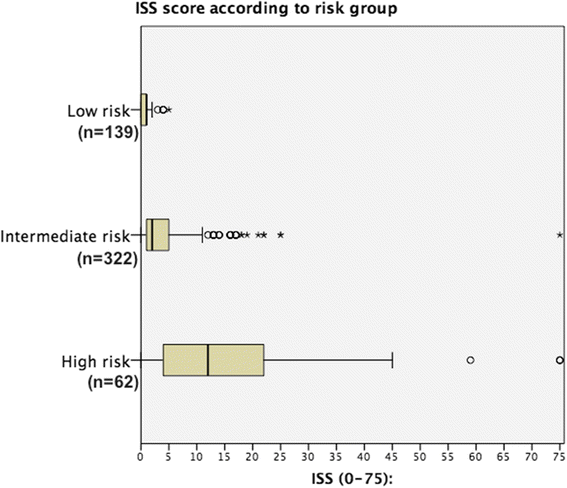Routine whole body CT of high energy trauma patients leads to excessive radiation exposure
- PMID: 26817669
- PMCID: PMC4729033
- DOI: 10.1186/s13049-016-0199-2
Routine whole body CT of high energy trauma patients leads to excessive radiation exposure
Abstract
Background: Whole body computed tomography (WBCT) is an important adjunct in trauma care, which is often part of standard protocol in initial management of trauma patients. However, WBCT exposes patients to a significant dose of radiation. The use of WBCT was assessed in a modern trauma cohort in Sweden.
Methods: A two-center retrospective cohort study was performed. All consecutive trauma alert patients at a university hospital (July-December 2008), and a rural county hospital (January 2009- December 2010) were included. Patients were stratified into three groups (high, intermediate and low risk) based on documented suspected injuries at primary survey at the site of accident or at the emergency department. Injury severity score (ISS) was calculated. Case records were reviewed for clinical and radiological findings at the time of trauma, and during a ≥36 months of follow-up period to identify possible missed injuries.
Results: A total of 523 patients were included in the study (university hospital n = 273; rural county hospital n = 250), out of which 475 patients (91.0 %) underwent radiological examinations, 290 patients (55.4 %) underwent WBCT, which identified trauma related findings in 125 patients (43.1 % of those examined). The high-risk group (n = 62) had a mean age of 38.5 years (21.1 SD). Mean ISS was 16.48 (18.14 SD). In this group, WBCT resulted in a positive finding in 38 (74.5 %) patients. In the intermediate-risk group (n = 322; mean age 37.66, 20.24 SD) ISS was 4.42 (6.30 SD). A positive finding on WBCT was found in 87 of the intermediate group patients (44.8 %). The low-risk group (n = 139; mean age 32.5 years; 21.4 SD) had a mean ISS of 0.84 (1.57 SD) with no positive findings on WBCT and no missed injuries in medical records at ≥36 months.
Discussion: The risk of developing radiation induced cancer is significant for young people if exposed to relatively high dose radiation as is the case in WBCT. WBCT in high-energy trauma is important for planning of treatment in severely injured patients while it can be questioned in the seemingly not injured where it is used mainly to permit early discharge from the ED.
Conclusions: Risk stratification criteria could in this retrospective study identify high energy trauma patients not in need of radiological imaging. WBCT in high-energy trauma does not affect patient care if the patient is mentally alert, not intoxicated nor shows signs of other than minor injuries when evaluated by a trauma-team. The risk of missing important traumatic findings in these patients is very low. Observation of the patient with reexamination instead of imaging may be considered in this group of often young patients where radiation dose is an issue.
Figures
Similar articles
-
The role of whole-body computed tomography in the diagnosis of thoracic injuries in severely injured patients - a retrospective multi-centre study based on the trauma registry of the German trauma society (TraumaRegister DGU®).Scand J Trauma Resusc Emerg Med. 2017 Aug 15;25(1):82. doi: 10.1186/s13049-017-0427-4. Scand J Trauma Resusc Emerg Med. 2017. PMID: 28810921 Free PMC article.
-
Association of Low-Dose Whole-Body Computed Tomography With Missed Injury Diagnoses and Radiation Exposure in Patients With Blunt Multiple Trauma.JAMA Surg. 2020 Mar 1;155(3):224-232. doi: 10.1001/jamasurg.2019.5468. JAMA Surg. 2020. PMID: 31940019 Free PMC article.
-
Whole body CT versus selective radiological imaging strategy in trauma: an evidence-based clinical review.Am J Emerg Med. 2017 Sep;35(9):1356-1362. doi: 10.1016/j.ajem.2017.03.048. Epub 2017 Mar 21. Am J Emerg Med. 2017. PMID: 28366287 Review.
-
A decision tool for whole-body CT in major trauma that safely reduces unnecessary scanning and associated radiation risks: An initial exploratory analysis.Injury. 2016 Jan;47(1):43-9. doi: 10.1016/j.injury.2015.08.036. Epub 2015 Sep 1. Injury. 2016. PMID: 26377772
-
Whole-body computed tomography in severely injured patients.Curr Opin Crit Care. 2018 Feb;24(1):55-61. doi: 10.1097/MCC.0000000000000474. Curr Opin Crit Care. 2018. PMID: 29140964 Review.
Cited by
-
Clinical guided computer tomography decisions are advocated in potentially severely injured trauma patients: a one-year audit in a level 1 trauma Centre with long pre-hospital times.Scand J Trauma Resusc Emerg Med. 2020 Jan 10;28(1):2. doi: 10.1186/s13049-019-0692-5. Scand J Trauma Resusc Emerg Med. 2020. PMID: 31924242 Free PMC article.
-
Prior CT imaging history for patients who undergo whole-body CT for acute traumatic injury and are discharged home from the emergency department.BMC Emerg Med. 2018 Oct 16;18(1):34. doi: 10.1186/s12873-018-0186-1. BMC Emerg Med. 2018. PMID: 30326855 Free PMC article.
-
Routine versus selective chest and abdominopelvic CT-scan in conscious blunt trauma patients: a randomized controlled study.Eur J Trauma Emerg Surg. 2018 Feb;44(1):9-14. doi: 10.1007/s00068-017-0842-2. Epub 2017 Sep 25. Eur J Trauma Emerg Surg. 2018. PMID: 28948295 Clinical Trial.
-
Epidemiological comparison between the Navarra Major Trauma Registry and the German Trauma Registry (TR-DGU®).Scand J Trauma Resusc Emerg Med. 2017 Nov 2;25(1):107. doi: 10.1186/s13049-017-0453-2. Scand J Trauma Resusc Emerg Med. 2017. PMID: 29096679 Free PMC article.
-
Negative Whole-Body Computed Tomography Scans in Polytrauma Patients: A Retrospective Cohort Study.Open Access Emerg Med. 2020 Oct 23;12:305-313. doi: 10.2147/OAEM.S263754. eCollection 2020. Open Access Emerg Med. 2020. PMID: 33122955 Free PMC article.
References
-
- American College of Surgeons Comittee on Trauma. Advanced Trauma Life Support Student Course Manual. 2008.
-
- Leidner B, Adiels M, Aspelin P. [Computer tomography. Life-threatening injuries of the skull, thorax, abdomen and pelvis are diagnosed in 15 minutes] Lakartidningen. 1994;91(12):1191. - PubMed
Publication types
MeSH terms
LinkOut - more resources
Full Text Sources
Other Literature Sources
Medical


